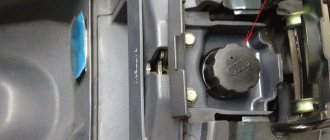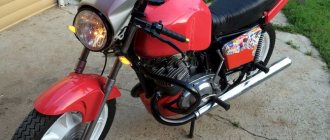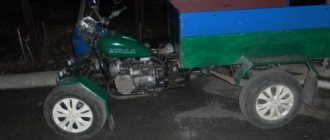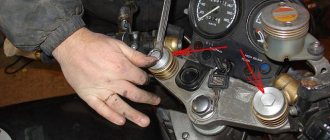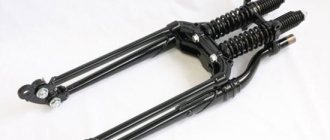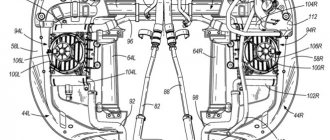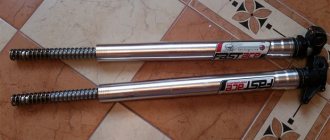The engine only ran 10 thousand km. Please help. And what should I put in the box?
Previously in the same section:
There are 35 comments left on this post.
Another one. Look in the topics. It's been discussed a hundred times.
stuff lard into it and you will be happy, and if you are serious, then I pour XADO 10W40 (not cheap, for 4 liters. 250 UAH (1000 rubles), semi-synthetic)
#1 mileage is a very inaccurate indicator, depending on what roads you drove on and what modes, loads, and so on.
I use XADO 15W40, change it every 6000
in general, it’s already for used engines (there’s a powerful additive package no matter how you look at it), I pour TNK 20W50 mineral water, in the summer the engine works much better against 10W40 (it seems like there’s less noise)))….
So what type of M 8 they say is not very good for the Dnieper.
pour the transmission tad 17 into the box yourself =) and into the engine mineral water, I personally pour shell helix))
75tis. nah) I’m not complaining yet)
83 thousand intensive care at XADO)
it all depends on the operating conditions, I pour 15W40 into the engine. in the box and GP also XADO transmission 80W90
#5 Yes, I wouldn’t say that it’s for gifts. If you initially pour Hado, the engine will last longer. only the first 300-400 km. It is better to run in some kind of swamp like TNK 20W50
My opinion is that it is better to pour XADO. already checked. just don't fall for a fake
#11 if you don’t mind pouring TAD-17 (everything will leak out anyway). I pour diesel into the box, but only TAD-17 into the bridge)
#17 So you’re asking the kind of questions that have been talked about here for a long time already. Find the topic, everything is written there, what where, why/why.
If you assemble the box normally, nothing will leak, the maximum amount of sweat will be on the seals
My engine has never been disassembled.
so on the seals (enough for a season) and the clutch release rod everything sticks out)
I use Castrol 5v40 synthetic, it makes the engine good)
With such gaps as on the boxer, synthetics will not help
so you can really say what is better for the Dnieper or not. tell me what needs to be poured so that the engine runs well and the oil light doesn’t come on.
If you have a standard economic council there, any oil is more expensive than $10 per liter, and everything will be ok. if you didn’t look up anything according to the documentation... the pump and liners are old, then use Kamaz... when it’s cold, at least there will be pressure... but it doesn’t matter if it heats up... By the way, my previous post was for a relatively living engine... with significant wear..
I don’t have a dead Dnepr, just tell me what is the best oil to pour so that the engine lives for a long time.
but there is such a thing. I just haven’t seen anything else on sale other than 10W40….
there is, but there is also a motorcycle 10v60, synthetic, I fed the Dnieper this season,,
SO IS THE NORMAL OIL FOR DNIPRE XADO 20B50?
damn, you asked, I answered, for ordinary stock, for trips of 10-20 km, it’s cheaper to pour in mineral water, because pouring 200 g of synthetics every 300 km is an expensive pleasure. With a well-assembled engine that does not consume oil, synthetics will give the engine a chance to live longer and reduce the likelihood of ending up on the road 600 km from home. and if you’re asking what kind of oil to pour, then I doubt that you assembled such an engine according to all the standards, measured all the fits, bored it to the required clearances, installed foreign oil seals,... at most, shook it with your hands, figured it out, twisted it, checked the runout and assembled it. so lei hado 20v50 and your oppositionist will thank you.
Source
Lubricant selection
Pouring fresh lubricant into the Ural fork is a responsible procedure. It is necessary to choose the oil very carefully, because the motorcycle clutch is completely submerged in lubricating fluid.
Motor oil should not be poured into a four-stroke Ural engine, because it has an inappropriate viscosity coefficient. Oil for bikes has a completely different set of additive elements.
- If the motorcycle is used all year round, which is surprising given the cold winters of Russia, pour a universal consumable into the engine. This oil has certain advantages over others because it contains special additives. Thanks to them, the lubricant is effective in low and high temperature conditions. Manufacturers of lubricating fluid that is poured into motorcycles carefully and for a long time test it under different temperature conditions.
- If the bike is used only in the summer, you can fill it with summer oil. This lubricant is common and perfectly lubricates internal combustion engines.
- When choosing the lubricant that you will pour into the bike, you need to take into account its viscosity index. In order for the engine to function smoothly, a fluid lubricating fluid is required that does not thicken in low temperature conditions. If the engine is significantly worn out, you can pour viscous lubricant into it, because a worn-out engine smokes when driving. Most Urals owners believe that even low-quality petroleum products are unable to harm the internal combustion engine.
- Since the Ural bike is considered a high-class motorcycle, its engine has characteristics that allow it to function under increased loads, even with severe wear. The Ural manufacturer recommends pouring M8B1 lubricant into it. It does not have the best reputation, but the internal combustion engine functions perfectly when it is filled.
Brand popularity
Although Ural is found everywhere in the Russian Federation, a large number of manufactured mopeds are sold to other countries. Only three percent of the total volume remains in Russia. This is due to the considerable cost of the motorcycle. For the same price it is possible to purchase a used car of excellent quality.
Realizing that this bike was very popular abroad, I decided to reconstruct it, started buying spare parts abroad, and carrying out the assembly in the Russian Federation. About a thousand bikes are produced annually and are already sold in advance. It’s hard to imagine which countries they drive on.
"Ural" is made on the basis of military bikes "BMW R71". They were produced by the Germans in the forties of the last century. The first “Ural” was manufactured during the Second World War and had additional devices that distinguished it from German motorcycles. To make the army more maneuverable and mobile, Iraq purchased many bikes from the Russian Federation. They were equipped with additional channels, machine guns and flamethrowers. It was after the Iraq war that America began to become interested in these bikes.
Recommendations for choosing motorcycle oil
The type of fluid chosen directly depends on the type of engine. He can be:
The second reason for making the right choice is precisely the classification of motor oil that we presented above. This is manufactured using three different technologies, which result in a mineral, semi-synthetic or synthetic material.
There are also not recommendations, but rather requirements on how to choose a product. In 1998, the Japanese standard JASO T 903 was developed, which specifies all the minimum and maximum permissible technical characteristics of fuels and lubricants for four-stroke motorcycles. One of the main criteria that distinguished the product from machine compounds was the behavior of the engine with a wet clutch. And if the liquid has not been certified according to JASO requirements, then it cannot be recommended for use by motorcycle manufacturers.
Below we will show other parameters that determine which oil is best to pour into a motorcycle.
sections:
IN THE URAL LEFT BOILER ZATIORLO COMPRESSION RINGS WHAT IS THE REASON
Hi all! This is the problem in the Urals, after wrapping the cylinders, heads, and adjusting the valves, the right cylinder fails, sneezes, shoots, starts working only at high speeds, and that’s not always the reason?
help me, I was driving in the Urals, everything was fine, then I sneezed and after that the right engine failed, no copresion. what should I do?
What kind of oil to pour into the gearbox of a Ural motorcycle
Oil must be poured into the gearbox of a Ural motorcycle taking into account the manufacturer’s recommendations and official maintenance. Synthetics have good fluidity compared to mineral oils. On the other hand, it is prone to leaks, especially if the vehicle has significant mileage.
Important! The density of synthetics minimally depends on the temperature of the environment during the cold season.
A synthetic transmission is an expensive, but practical option. Semi-synthetic is a hybrid, an averaged version between the other two species. Mineral products are the cheapest, the quality is satisfactory.
Messages [1 to 20 of 32]
1↑ Topic from BETERR 09/01/2014 09:54:16
Topic: Oil in the Dnieper
2↑ Reply from shaman507 09/01/2014 09:58:41
Re: Oil in Dnepr
Digest
3↑ Reply from BETERR 09/01/2014 10:09:45
Re: Oil in Dnepr
Digest
Yes, I think so too. But it’s better to play it safe and ask knowledgeable people.
4↑ Reply from shaman507 09/01/2014 10:19:39
Re: Oil in Dnepr
Diesel oils are even better than regular oils, so don’t worry, lei.
5↑ Reply from BETERR 09/01/2014 10:37:25
Re: Oil in Dnepr
Diesel oils are even better than regular oils, so don’t worry, lei.
Do I need to wash it? My M8 is flooded.
6↑ Reply from Severo 09/01/2014 10:58:55
Re: Oil in Dnepr
_flushing will ruin the new oil.. lei. Although it will be liquid at operating temperatures, it will generally work. ps better than M8 100% )))
Edited by Severo (01-09-2014 11:00:40)
7↑ Reply from BETERR 09/01/2014 11:22:46
Re: Oil in Dnepr
_flushing will ruin the new oil.. lei. Although it will be liquid at operating temperatures, it will generally work. ps better than M8 100% )))
Will it curdle when mixed?
8↑ Reply from Severo 09/01/2014 12:18:25
Re: Oil in Dnepr
_just drain completely, of course there will still be a residue that is not drained, but not so significant that it will affect it. When changing the type of oil, it is better to reduce the first mileage, and then roll back the required one.
9↑ Reply from shaman507 09/01/2014 12:30:25
Re: Oil in Dnepr
Do I need to wash it? My M8 is flooded.
Do you think flushing is better than M-8? Flushing is the cheapest crap.
10↑ Reply from 666 01-09-2014 13:41:18
Re: Oil in Dnepr
Edited 666 (01-09-2014 13:41:49)
11↑ Reply from Severo 09/01/2014 13:47:19
Re: Oil in Dnepr
_firstly, there is no “flushing oil”. Turn any similar product over and on the back it will say flushing fluid. This is not oil, but an aggressive chemical. If you use good oil, there are excellent detergent additives, and therefore, good oil will clean better than flushing and will not ruin the engine (when, as on flushing, they say not to use longer than 8-10 minutes, and correctly the engine will not last long under such stress) .You just need to shorten the first change interval, not full, for example 10k, but 7-8, the first change is with good oil and will work as a flush. Secondly, serious companies do not make flushes under their brand and not a single car manufacturer uses “these flushes”. /will not advise motorcycles.
Edited by Severo (01-09-2014 13:47:44)
12↑ Reply from drakone 01-09-2014 13:55:56
Re: Oil in Dnepr
For me, it’s better to fill it, drive it a couple of times and drain it, thereby flushing the engine of old oil, rather than pouring in any mixtures
13↑ Reply from 666 09/01/2014 14:06:10
Re: Oil in Dnepr
For me, it’s better to fill it, drive it a couple of times and drain it, thereby flushing the engine of old oil, rather than pouring in any mixtures
Fill and drain at least three hundred times.. You won’t be able to flush the engine from carbon deposits and tars.. You need to use EXACTLY the flush.. As the North said.. aggressive chemistry.. you can call it that, no one said that the flush is oil.. So I repeat only with this *aggressive chemistry* and it’s possible to flush the engine..
If you use good oil, there are already excellent detergent additives, and therefore good oil will clean better than flushing and will not ruin the engine
Edited 666 (01-09-2014 14:06:59)
Source
Oil in box
pedestrian Thu, 02/19/2009 — 13:05
Answer: The API designation of a specific oil helps the consumer choose the right gear oil for their vehicle. Currently, the accepted API marking includes 5 GL categories: GL-1, GL-2, GL-3, GL-4, GL-5, respectively. There is also a category GL-6 or MT-1, but it is not widely used in Europe. An increase in the GL index means an increase in the load on the structural elements of the gearbox and differential and, accordingly, an increase in the number of additives that provide wear protection. Oil with the lowest category GL-1 is intended for non-synchronized gearboxes with light loads and is typically used in certain types of trucks. GL-2 oils belong to the category of industrial gear oils and are widely used in vehicles with classification according to API GL-4 and GL-5. Their main difference, as already mentioned, is the number of additives: GL-5 has more of them than GL-4. Since additives are chemical compounds of sulfur and phosphorus that are aggressive towards copper alloys, GL-5 oil can cause corrosion of structural elements of the box, in particular synchronizers designed for the use of GL-4 oil, and vice versa, the use of GL-4 oil instead recommended GL-5 will cause rapid gear wear. Therefore, every manufacturer of transmissions and gearboxes must indicate which API-classified oil must be used and you should not neglect their recommendations - this may in the future threaten the repair of an expensive unit. It is worth noting that many manufacturers produce oils with dual API classifications. For example, Liqui Moly produces semi-synthetic oil Hypoid Getribeoil SAE 75W-90 TDL with classification GL-4/5. This means that the oil can be used for transmissions and differentials requiring both GL-4 and GL-5 oils.
When do you need to change the oil in the gearbox and engine?
Motor vehicles require careful maintenance. It is recommended to check the tightness of nuts, bolts, and other fasteners on the gearbox daily or before each trip. Every couple of thousand kilometers you should check the content of the working fluid and top up if necessary.
You cannot ignore scheduled vehicle maintenance - this is a guarantee of safety.
Every 10 thousand km it is recommended to pour new transmission fluid into the gearbox or engine. The work intervals can be adjusted at your discretion. Much will be determined by operating conditions and the quality of the unit.
Important! Additionally, it is necessary to check the lubricant level in the system and evaluate its quality. Unscheduled maintenance may be required.

